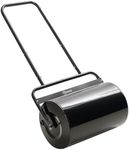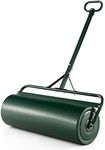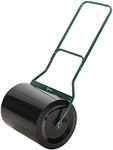Buying Guide for the Best Lawn Rollers
Choosing the right lawn roller can make a significant difference in maintaining a smooth and even lawn. Lawn rollers are used to flatten the soil, remove air pockets, and ensure that seeds make good contact with the soil. When selecting a lawn roller, it's important to consider several key specifications to ensure you get the best fit for your needs. Understanding these specifications will help you make an informed decision and achieve the best results for your lawn care routine.MaterialLawn rollers are typically made from either steel or polyethylene. Steel rollers are more durable and can handle tougher jobs, making them ideal for larger or more uneven lawns. However, they are heavier and can be more difficult to maneuver. Polyethylene rollers are lighter and easier to handle, making them suitable for smaller lawns or for those who prefer a more manageable tool. Consider the size and condition of your lawn when choosing the material of your lawn roller.
WeightThe weight of a lawn roller is crucial because it determines how effectively it can flatten the soil. Lawn rollers can be filled with water or sand to increase their weight. Lighter rollers (up to 200 pounds) are suitable for small, residential lawns and for tasks like pressing down seeds. Medium-weight rollers (200-400 pounds) are good for medium-sized lawns and more moderate tasks. Heavy rollers (over 400 pounds) are best for large lawns or for dealing with very uneven ground. Choose a weight that matches the size of your lawn and the specific tasks you need to perform.
WidthThe width of the lawn roller affects how much ground you can cover in a single pass. Narrow rollers (under 24 inches) are easier to maneuver and are ideal for small lawns or tight spaces. Medium-width rollers (24-36 inches) offer a good balance between coverage and maneuverability, making them suitable for medium-sized lawns. Wide rollers (over 36 inches) cover more ground quickly, which is beneficial for large lawns but can be harder to handle. Consider the size of your lawn and how much time you want to spend rolling it when choosing the width.
Handle TypeLawn rollers come with different handle types, including push handles and tow-behind handles. Push handles are designed for manual operation and are suitable for small to medium-sized lawns. They offer more control and are easier to use in tight spaces. Tow-behind handles are designed to be attached to a lawn tractor or ATV, making them ideal for large lawns or for those who prefer not to push the roller manually. Choose a handle type based on the size of your lawn and your preferred method of operation.
Drainage PlugA drainage plug is a feature that allows you to easily fill and empty the roller with water or sand. This is important for adjusting the weight of the roller to suit different tasks. A roller with a convenient drainage plug makes it easier to switch between different weights and to store the roller when not in use. Look for a roller with a well-designed drainage plug if you anticipate needing to adjust the weight frequently or if you want to make storage easier.














